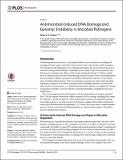| dc.contributor.author | Shapiro, Rebecca | |
| dc.date.accessioned | 2015-05-29T15:50:35Z | |
| dc.date.available | 2015-05-29T15:50:35Z | |
| dc.date.issued | 2015-03 | |
| dc.identifier.issn | 1553-7374 | |
| dc.identifier.issn | 1553-7366 | |
| dc.identifier.uri | http://hdl.handle.net/1721.1/97122 | |
| dc.description.abstract | Combatting infectious disease is a critical global health concern and involves tackling both emerging infectious agents and newly–drug resistant strains of previously curable pathogens. The widespread and inappropriate use of antimicrobial agents has increased the frequency of resistance among human pathogens, including bacteria, fungi, and protozoan parasites, and threatened to undermine the efficacy of all existing antimicrobial drugs. Whereas lethal doses of antimicrobials may select for preexisting resistant microbes, there is increasing interest in uncovering the cellular consequences of sublethal antimicrobial exposure on the development of antimicrobial resistance. There are numerous circumstances under which microbial organisms are exposed to low doses of antimicrobials, including in patients, in livestock animals, and in the environment. Sublethal antimicrobial exposure can trigger DNA damage and genomic instability across the diversity of microbial pathogens, including bacterial and fungal species. | en_US |
| dc.description.sponsorship | Banting Postdoctoral Fellowship | en_US |
| dc.language.iso | en_US | |
| dc.publisher | Public Library of Science | en_US |
| dc.relation.isversionof | http://dx.doi.org/10.1371/journal.ppat.1004678 | en_US |
| dc.rights | Creative Commons Attribution | en_US |
| dc.rights.uri | http://creativecommons.org/licenses/by/4.0/ | en_US |
| dc.source | Public Library of Science | en_US |
| dc.title | Antimicrobial-Induced DNA Damage and Genomic Instability in Microbial Pathogens | en_US |
| dc.type | Article | en_US |
| dc.identifier.citation | Shapiro, Rebecca S. “Antimicrobial-Induced DNA Damage and Genomic Instability in Microbial Pathogens.” Edited by Deborah A. Hogan. PLoS Pathog 11, no. 3 (March 26, 2015): e1004678. | en_US |
| dc.contributor.department | Institute for Medical Engineering and Science | en_US |
| dc.contributor.department | Massachusetts Institute of Technology. Department of Biological Engineering | en_US |
| dc.contributor.department | Massachusetts Institute of Technology. Synthetic Biology Center | en_US |
| dc.contributor.mitauthor | Shapiro, Rebecca | en_US |
| dc.relation.journal | PLOS Pathogens | en_US |
| dc.eprint.version | Final published version | en_US |
| dc.type.uri | http://purl.org/eprint/type/JournalArticle | en_US |
| eprint.status | http://purl.org/eprint/status/PeerReviewed | en_US |
| dspace.orderedauthors | Shapiro, Rebecca S. | en_US |
| dc.identifier.orcid | https://orcid.org/0000-0001-8167-7096 | |
| mit.license | PUBLISHER_CC | en_US |
| mit.metadata.status | Complete | |
